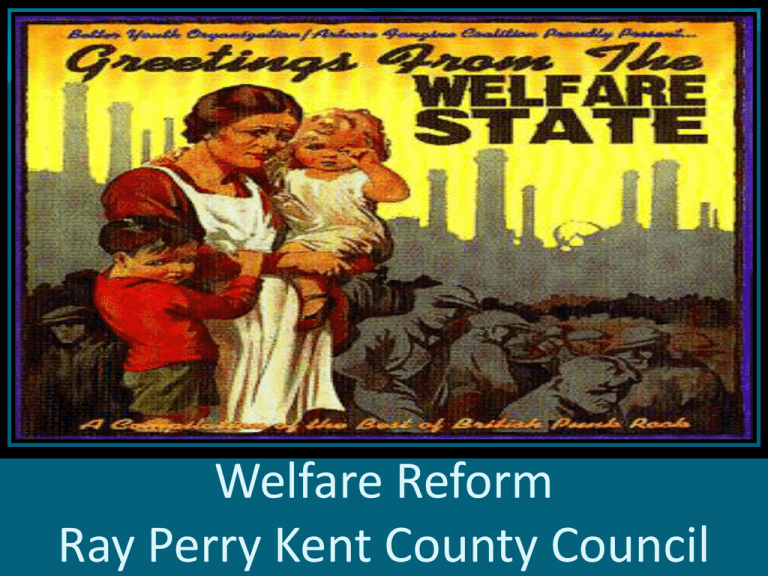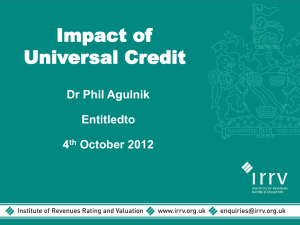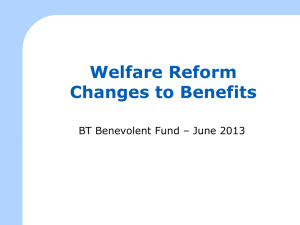Welfare Reform
advertisement

Welfare Reform Ray Perry Kent County Council Introduction The next few years will see profound changes to the welfare system in the UK The changes proposed are aimed at making savings of a staggering £18 billion a year by 2015 These radical reforms will change the whole landscape of welfare provision and will have the greatest impact on two groups Families with Children & Sick and disabled people The main changes Reassessment of IB claimants Disability Living Allowance reform Universal Credit Sick and disabled people Reassessment of 1.5 million people currently in receipt of Incapacity Benefit, Income Support on the grounds of sickness and Severe Disablement Allowance Controversy surrounding the Work Capability Assessment Trials in Burnley and Aberdeen found 30% fit for work which, if mirrored nationally, would result in 450,000 losing benefit entitlement Nationwide rollout started in February 2011 and will be completed by 2014 Everyone will be reassessed ! Sick and disabled people Does the person have limited capability for work? ESA 50 form completion – points scoring! Medical with Atos Origin Health Care Professional Decision “fit for work” = Job Seekers Allowance Limited capability proven = placed in either The Support Group or Work Related Activity Group Appeal Flawed Work Capability Assessment forwarded to Disability Living Allowance Unit for review of entitlement to DLA Sick and disabled people Support from LMBBS via web site ESA checklists How to complete your ESA 50 Atos Origin guide to their Health Care Professionals DWP Customer Journey Appeal guidance My e-mail address The Personal Independence Payment To replace Disability Living Allowance for people of working age from 2013-2014 “Fairer , objective assessment” but 20% cut in expenditure Two components and two rates of new Mobility and Daily Living components Six month rather than three month “qualifying period” Client is required to discuss their circumstances with a DWP approved Health Care Professional All awards subject to periodic review The Personal Independence Payment PIPs will be as DLA is at present– non means-tested non taxable and a passport for other benefits “Special Rules” for the terminally ill remain Greater duty to report changes in health conditions with the introduction of legal and financial penalties if not reported Everybody with the exception of “Special Rules” cases will be re-assessed Confused picture not sure if PIPs will replace DLA for children Universal credit Replaces existing means-tested benefits and tax credits for people of working age, including IS, income-based JSA, income-related ESA, HB, Child Tax Credit and Working Tax Credit Basic allowance for adults plus additions for children, disability, housing costs and caring Assessed and paid on household basis Reduced by 65 pence for each £1 of net earnings after applying a disregard Entitlement will be automatically adjusted as earnings vary using “real time” PAYE data from HMRC Universal credit Universal Credit will be administered centrally by the DWP with the majority of claims made, assessed and delivered electronically Cap on household benefit payments will mean that those not in receipt of DLA, War Widows or receiving WTC will be limited to the median level of earning of working families Limited help with mortgage interest for those in work Council Tax support schemes will be much more localised and variable from place to place Universal credit Community Care Grants and Crisis Loans devolved to local authorities Current rules that base entitlement to passported benefits, such as free school meals & prescription charges on receipt of certain benefits will be replaced by a system that bases entitlement on an income or earnings threshold Increased conditionality for Jobseekers Pilot in October 2013 For all new claims from April 2014 Full transfer of all claimants by October 2017 Universal credit Introducing Universal Credit will be a huge and complex undertaking and the Government has set itself a very tight timescale Crucial to the implementation and success of Universal Credit is the development of two new IT systems – one for the assessment of Universal credit and a second system to obtain “real time “ PAYE details Universal Credit will be an integrated benefit. Households who claim will automatically receive everything they are entitled to Universal credit The objective of a simpler, more transparent scheme which is easier for claimants to understand and with clear work incentives commands widespread support but there is concern over lack of detail on key elements Taper rate of 65% (76% after tax) low enough to make work pay? What about the self-employed? How is help with childcare costs to be provided? Will UC penalise those with savings? Transitional protection Families with children Families face major benefit and tax credit changes before the introduction of Universal Credit Child Benefit frozen for three years and the Child Benefit clawback for higher rate taxpayers Tax Credit changes Housing Benefit changes Abolition of Child Trust Fund, Health in Pregnancy grant and Sure Start Maternity for second and subsequent children The next few years For those who need and rely on state benefits it’s going to be a very bumpy ride over the next few years with lots of uncertainty, change and re-assessment The re-assessment of those on Incapacity Benefits has just started and there is great concern that many people will be incorrectly found not to have limited capacity for work. Please use the tools and guidance on the web pages Any Questions?











